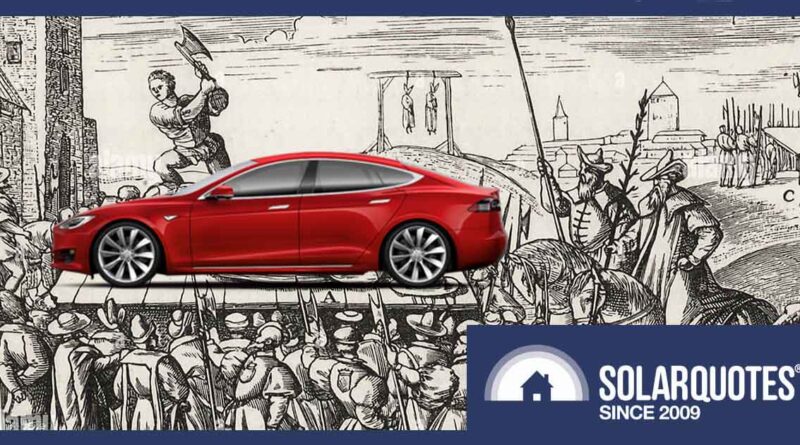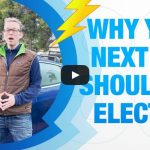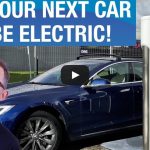10 Lessons In History That Tell Us Electric Vehicles Are Here To Stay
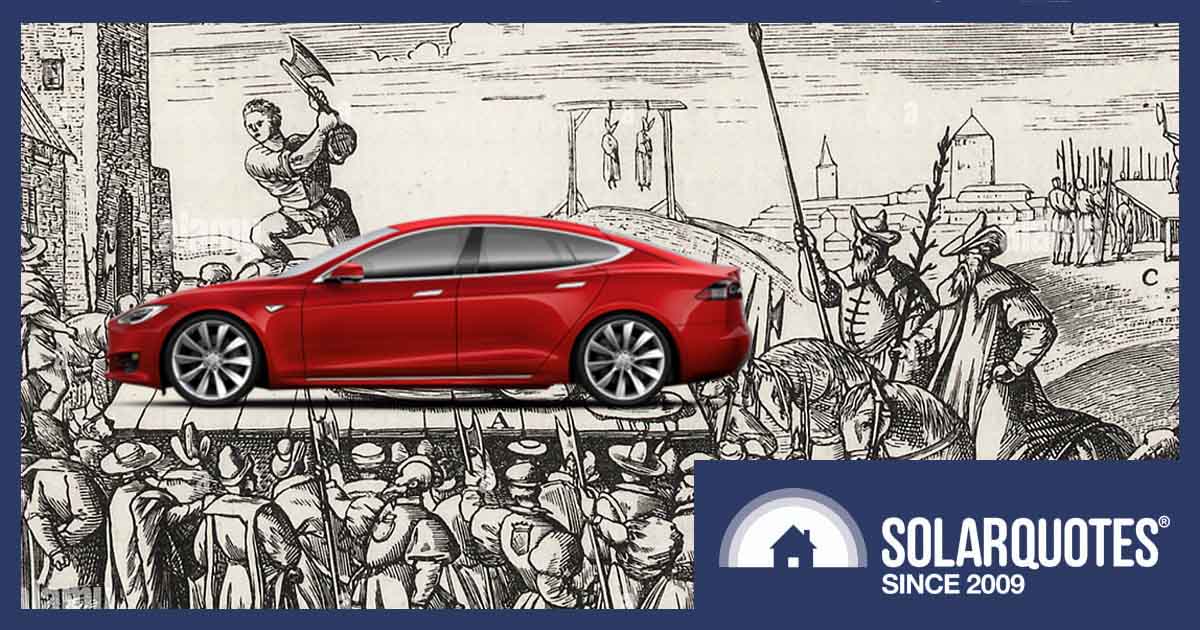
The widespread adoption of electric vehicles in Australia is not without challenges, one of which is overcoming resistance to change. It seems that no matter how credible the case for EV adoption is, there is always a chorus of naysayers in the background trying to undermine the consensus.
This article will turn the narrative away from the usual arguments of logic, which often fall on deaf ears, to a short history lesson showing when it comes to technology advancement, resistance is futile. Electric vehicles are here to stay.
What Is It With These EV Naysayers?
Although these contrarian voices often have implausible arguments, they do have legitimate concerns.
A recent article appearing in The Australian newspaper about the cost of electric vehicles featured some quotes from Finn Peacock, founder of SolarQuotes.
Despite Finn’s balanced commentary about his lived experience with electric vehicles, the comments section at the end of the article was filled with statements such as:
“Made in China to make savings? At other people’s expense. Where will you park that battery?”
“EVs are cheaper if the government tips in cash – When will renewables be really cheapest?”
“And of course, there are all the environmental costs of producing and then recycling the batteries, which are not factored into these costs.”
“No mention of the $20,000 battery you have to install on your home solar system to charge your EV at night. That battery will require replacement every 7-10 years.”
Some of the above readers’ concerns are valid and have been addressed many times. Others are pure nonsense, based on fear, not fact.
Drivers Of Contrarian Beliefs
There are many drivers for contrarian beliefs, particularly when faced with new technology. The list is long, and may not apply to everyone. Here are some:
- Vested interests
- Fear of the unknown
- Cultural and social factors
- Nostalgia
- Perceived risks
- Technological complexity
- Job insecurity
- Political influence
Generational Bias
Hey Boomers1, I’m not picking on you for the sake of it. Just stating a fact that’s relevant to the conversation. You can’t deny that the older generation has shown time and time again to be more likely to exhibit skepticism or resistance due to unfamiliarity. Meanwhile, younger generations tend to be more adaptable and open to integrating new tech into their lives. Age may bring experience, but not necessarily insight.

Why Widespread EV Adoption Is Inevitable
Disruptive Technologies
Disruptive technologies are innovations that significantly revolutionise industries and the way we live. They often start as niche solutions but eventually replace traditional methods and create new opportunities and jobs.
Some examples of disruptive technologies in the past have included the steam engine, electricity, the internal combustion engine, the personal computer, etc. More recently – the internet, artificial intelligence, and renewable energy.
Forward Thinkers
Among the world’s foremost forward thinkers in this area is author and entrepreneur Tony Seba, known for his perspective on the disruptive potential of electric vehicles. He is one among many that believe the convergence of advancements in battery technology, declining costs, and supportive policies will accelerate the inevitable transition from ICE (internal combustion engine) vehicles to EVs.
He’s not the only forward thinker with this vision. Other EV advocates that believe EV dominance is a done deal read like the who’s who of the entrepreneur and tech world – Elon Musk, Bill Gates, Saul Griffith, Mary Barra, Bill McKibben, Chris Paine, and Lewis Hamilton, to name a few.
Exponential Rate Of Tech Change
The speed at which disruptive technologies and innovation have taken over in recent years is exponential. A prime example is rooftop solar power in Australia. You can’t help but notice that, unlike 10 years ago, it’s everywhere you look.
This rapid acceleration is a typical pattern that occurs as new disruptive innovations are introduced, leading to increasingly faster and more profound changes. Although not specific to all technologies, this phenomenon is often described by Moore’s Law, which states that the processing power of computers doubles approximately every two years.
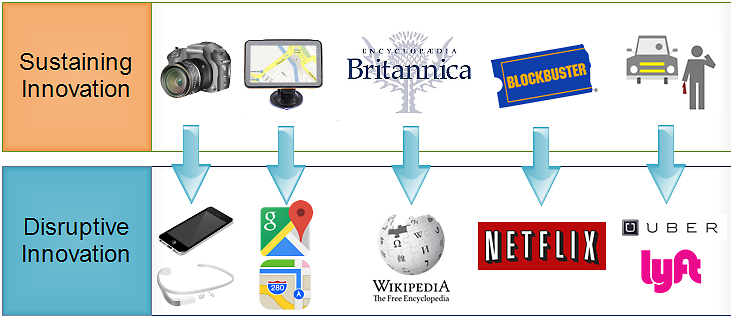
Some modern day disruptive innovation examples. Image: Alaa Khamis
10 Lessons In History From Disruptive Innovators
We can’t predict the future, but it’s possible to look into the past for a clue as to what might lie ahead. The following are examples from our history books showing disruptive technologies and innovations that have changed society, and the futile attempts at stopping them.
#1 The Printing Press: Scribes vs. the Press
Johannes Gutenberg’s printing press, invented in the 15th century, faced resistance from religious authorities, scribes, and scholars who feared its potential to spread unauthorized ideas. Concerns about heretical texts, the economic impact on artisans, and the need for censorship led to attempts at regulation and book burnings. The printing press eventually succeeded, even though modern digital screens like the one you’re reading are now taking their place.
#2 The Industrial Revolution: Luddites vs. Machinery
The Industrial Revolution in the 18th and 19th centuries faced resistance, with events like the Luddite protests against mechanization and concerns about poor labor conditions. However, innovations such as steam engines and factory systems drove economic growth. The Industrial Revolution’s technological progress and societal changes ultimately led to improved living standards, and yet, ironically, its legacy includes today’s heightened environmental awareness and concerns about sustainability.
#3 The Telephone: An Electrical Toy!
During the late 19th century, the telephone encountered initial skepticism and opposition. Established communication systems like telegraphy were deeply rooted and considered reliable. Notable events included a lack of interest from Western Union in acquiring Alexander Graham Bell’s telephone patent in 1876 and a dismissive telegram from the President of Western Union that read, “What use could this company make of an electrical toy?”
#4 Electricity: A Hard Sell
Believe it or not, electricity was a hard sell for power companies in the 1920s. They had to convince people that their product was useful! An advert from The New York Tribute read “With electricity, business owners can light a shop and factory in order to prevent accidents, increase output, or help ventilate a room. The direct application of power to a machine increases efficiency, and reduces the amount of heavy, exhausting labor.”
#5 The Automobile: Horse-Drawn Legacy vs. Cars
The introduction of the automobile in the late 19th century also faced huge opposition. Horse-drawn carriage industries feared job losses, safety concerns led to speed limits, and flag-waving regulations. Despite this, innovators such as Karl Benz and Henry Ford improved designs and car manufacturing techniques, and today there are almost 1.5 billion cars on the road worldwide. That’s one for every five people on earth!
#6 Radio And Television: Our Favourite Pastime
Radio pioneers like Guglielmo Marconi, who demonstrated wireless communication in the late 19th century, faced doubters about the practicality and reliability of radio waves for long-distance communication. Similarly, television faced resistance, with a famous quote from Darryl Zanuck, a prominent film producer, claiming that people wouldn’t want to watch television because “people will soon get tired of staring at a plywood box every night.” Wrong!
#7 Personal Computers: Pen And Paper vs. Pixels
Some experts in the 1970s initially questioned the practicality of personal computers. Yet, trailblazers including Steve Jobs and Bill Gates persisted, launching products like the Apple I and Microsoft’s first operating system. As technology advanced and prices dropped, personal computers gained popularity in the 1990s, and today they’ve become an integral part of our daily lives.
#8 Renewable Energy: Skepticism To Mainstream Acceptance
Many working in the solar industry know this one too well. Renewable energy has triumphed as a mainstream energy source despite initial opposition from entities with vested interests and continued reluctance from certain groups clinging to outdated paradigms. Technological strides from the early 2000s onwards enhanced their affordability. Solar and wind power has experienced exponential growth since then. Today there are more than 3.5 million rooftop solar systems installed around Australia.
#9 The Internet: An Over-hyped Phenomenon!
Can you believe this? Media coverage in the 1990s portrayed the Internet as a passing fad or over-hyped phenomenon. Critics questioned whether the average person would embrace the complexities of using the World Wide Web. Many questioned whether a global network of interconnected computers could serve useful purposes beyond academic or military research. They grossly underestimated our insatiable appetite for watching cat and dog videos!
#10 Online Banking: From Banking Cheques To Checking Phones
The rise of online banking initially encountered huge resistance and took a few years to catch on, particularly by the older generation. There were concerns about security breaches, fraud, and the loss of personal touch. Now everyone shudders at the thought of lining up at the bank to cash a cheque.
The Final Nail In The ICE Vehicle’s Coffin
As the examples above have seen, electric vehicle production is at the cusp of a disruptive cycle in the automobile industry. Right now we’re in the early stages of an exponential curve for worldwide EV adoption. Think 2010 for the Australian rooftop solar industry.
The numbers are still low but exponential growth is there already, and about to explode. The International Energy Agency predicts a growth of 35% in 2023.
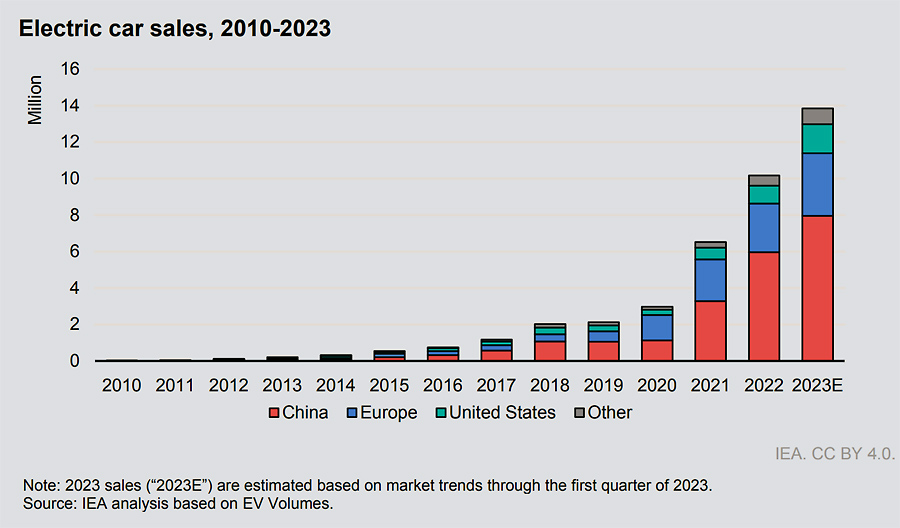
Annual worldwide EV sales 2010 to 2023. Image: International Energy Agency
Car manufacturers have had their eyeballs all over this for a long time, and have now firmly placed their bets. Tesla is the poster child for the EV revolution and now almost all major brands have followed, announcing all-electric models. Some of the world’s most iconic brands have made commitments to phase out internal combustion engines totally. This is the current state of play:
| Car Manufacturer | Commitment |
|---|---|
| Alfa Romeo | All electric by 2027. |
| Alpine (Renault) | All electric by 2030. |
| Audi | Final ICE vehicle in 2026. |
| Bentley | All electric by 2030. |
| Citroen DS | All electric by 2024. |
| Fiat | All electric by 2030. |
| Ford (Europe) | All electric by 2030. |
| General Motors | Final ICE vehicle in 2035. |
| Genesis | All electric by 2025. |
| GWM Haval | Cease ICE production by 2030. |
| Honda | Zero emissions by 2040. |
| Jaguar | All electric by 2025. |
| Lexus | All electric by 2035. |
| Maserati | All electric by 2030. |
These companies aren’t making pledges because of their commitment to a clean environment, or survival of the planet. They’re doing it because of their commitment to shareholders, and economic survival. They’re in the business of selling cars, not collecting them. This fact alone virtually guarantees that EVs will reach price parity with ICE vehicles very shortly, and leave them for dust.
In addition to the above, many countries have begun phasing out fossil fuel cars, and set deadlines for ending sales of petrol and diesel vehicles. Norway is the leader of the pack with new vehicles, either electric or hydrogen, to be sold from 2025. Britain, Singapore, and Israel are banning sales of new ICE vehicles in 2030.
China is aiming for sales of EVs to account for a majority by 2035. The USA is going one better, planning half of new cars sold in the United States to be zero-emissions in 2030. The European Union, a 27-nation bloc, has set deadlines for ending sales of ICE vehicles by 2035, and within the EU, Ireland, the Netherlands, and Sweden have set higher targets of shifting to zero-emission vehicles by 2030.
Silencing The Electric Car Skeptics
History teaches us that every innovation faces its fair share of skepticism. Electric vehicles are no exception. From the printing press to the internet, the naysayers have consistently been proven wrong. My advice to any doubters still meandering out there – embrace the EV revolution or move over – you’re blocking the fast lane.
Footnotes
- Not all of you (I’m one too!) ↩
Original Source: https://www.solarquotes.com.au/blog/history-electric-vehicles/

